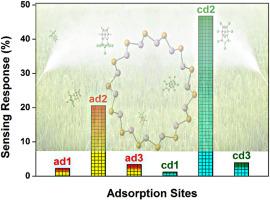用β-磷化砷纳米管检测有毒艾德林和氯丹分子-第一性原理的观点
IF 3
4区 生物学
Q2 BIOCHEMICAL RESEARCH METHODS
引用次数: 0
摘要
近年来,一种低维半导体材料由于其优异的结构和电子特性而引起了人们的极大兴趣。由于其可调谐的性质,它可以用于各种潜在的应用,包括化学传感器。本研究以β-磷化砷纳米管(β-AsP NT)为基材,对艾德林和氯丹这两种重要的杀虫剂进行了检测。首先,利用声子带图和地层能量来确定结构的坚固性。此外,β-AsP NT的能带结构和投射态谱密度描述了β-AsP NT的电子性质,计算出β-AsP NT的能隙为1.268 eV,显示出半导体性质。这些有毒污染物在β-AsP NT上的吸附行为通过相对带隙变化、电荷转移分析和吸附能等重要参数得到证实。吸附能(- 0.315 eV ~ - 0.974 eV)范围内表明污染物被β-AsP NT物理吸附,带隙变化最大的是吸附目标污染物aldrin和氯丹,在β-AsP NT的顶部位置。综合结果表明,所提出的β-AsP NT可以作为一种有效的化学电阻传感器,在环境条件下检测目标污染物。本文章由计算机程序翻译,如有差异,请以英文原文为准。

Detection of toxic aldrin and chlordane molecules using β-arsenic phosphide nanotubes – a first-principles perspective
Recently, a low-dimensional semiconducting material has shown great interest owing to its excellent tunable nature with regard to structural and electronic properties. Due to its tunable nature, it can be utilized in various potential applications, including chemical sensors. In the present research study, we employed β-arsenic phosphide nanotubes (β-AsP NT) as a base material to detect aldrin and chlordane pollutants, which are prominent insecticides. At first, the structural firmness is confirmed with phonon-band maps and formation energy. Furthermore, band structure and projected density of states spectrum portray the electronic properties of the β-AsP NT. The energy gap of β-AsP NT is calculated to be 1.268 eV, showing a semiconducting nature. The adsorption behaviour of these toxic pollutants on β-AsP NT is confirmed by the significant parameters, namely relative band gap changes, charge transfer analysis, and adsorption energy. The adsorption energy (−0.315 eV to −0.974 eV) within the range reveals that the pollutants are physisorbed on β-AsP NT. The maximum band gap variation is obtained upon the adsorption of target pollutants aldrin and chlordane, on the top-site of β-AsP NT. The overall outcomes suggest that the proposed β-AsP NT can be efficiently utilized as a chemo-resistive sensor to detect target pollutants under ambient conditions.
求助全文
通过发布文献求助,成功后即可免费获取论文全文。
去求助
来源期刊

Journal of molecular graphics & modelling
生物-计算机:跨学科应用
CiteScore
5.50
自引率
6.90%
发文量
216
审稿时长
35 days
期刊介绍:
The Journal of Molecular Graphics and Modelling is devoted to the publication of papers on the uses of computers in theoretical investigations of molecular structure, function, interaction, and design. The scope of the journal includes all aspects of molecular modeling and computational chemistry, including, for instance, the study of molecular shape and properties, molecular simulations, protein and polymer engineering, drug design, materials design, structure-activity and structure-property relationships, database mining, and compound library design.
As a primary research journal, JMGM seeks to bring new knowledge to the attention of our readers. As such, submissions to the journal need to not only report results, but must draw conclusions and explore implications of the work presented. Authors are strongly encouraged to bear this in mind when preparing manuscripts. Routine applications of standard modelling approaches, providing only very limited new scientific insight, will not meet our criteria for publication. Reproducibility of reported calculations is an important issue. Wherever possible, we urge authors to enhance their papers with Supplementary Data, for example, in QSAR studies machine-readable versions of molecular datasets or in the development of new force-field parameters versions of the topology and force field parameter files. Routine applications of existing methods that do not lead to genuinely new insight will not be considered.
 求助内容:
求助内容: 应助结果提醒方式:
应助结果提醒方式:


